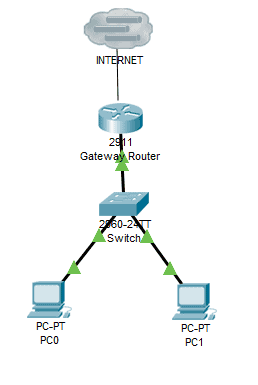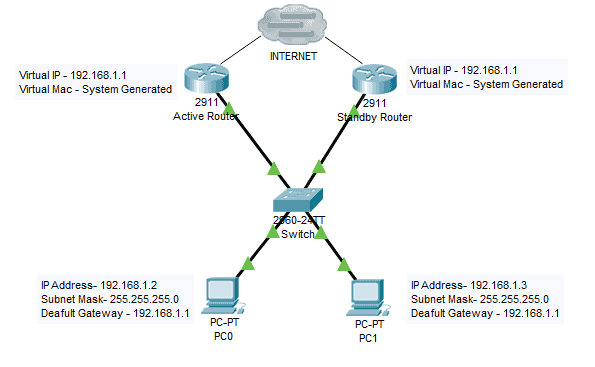In every host within the organization’s network, there should be a need for a router as the default gateway for every host to connect to the Internet. But what if the gateway router goes offline or the default gateway IP is changed during configuration?
Replacing the gateway router will cause a longer service interruption to the users within the organization, and that is not a reactive way to handle the issue. This is where FHRP will take place.
The below diagram is an example of a network topology without FHRP implementation:
What is First Hop Redundancy Protocol (FHRP)?
First Hop Redundancy Protocol (FHRP) is a hop redundancy protocol that is designed to provide redundancy to the gateway router within the organization’s network by the use of a virtual IP address and virtual MAC address.
To implement FHRP, there should be two or more routers that will be used as a gateway router. The virtual IP address and virtual MAC address will be used on both the router. The virtual IP address will be the default gateway IP address for all the devices inside the organization’s network. One router will be used as an active router (gateway router), and the other router will be standby. If the active router goes offline, the standby router will take its place to be the gateway router for all the hosts.
The below diagram is an example of network topology with FHRP implemented:
First Hop Redundancy Protocol (FHRP) Options
We have three ways to implement FHRP. These are by using the following First Hop Redundancy Protocols:
- Hot Standby Router Protocol (HSRP)
HSRP, or Hot Standby Router Protocol, is a Cisco-proprietary router redundancy protocol that enables a cluster of routers to cooperate, and all routers are willing to be a default router. All the routers within the cluster will have the same virtual IP address and virtual mac address.
The Two Hot Standby Router Protocol (HSRP) Router States:
- Active Router– the router that actively sends and receives a packet to the host within the organization. It is the default gateway router. Only one active router will be selected among the cluster of routers.
- Standby Router– the router/s that in case the incumbent active router will go offline, among the standby router will be chosen as the active router.
If the active router goes offline, router failover will occur. These changes will not affect the hosts. The host keeps the same IP address and MAC address setting. The default gateway IP address will be the same still on all hosts. There will be no changes on the host’s ARP table as the gateway router’s virtual MAC address will be the same. Changes in failover only happen on router and switch, and hosts are not affected.
Preemption in HSRP is not enabled by default. Preemption must be configured manually on the router.
- Virtual Router Redundancy Protocol (VRRP)
VRRP, Virtual Router Redundancy Protocol, is a vendor-neutral redundancy protocol that groups a cluster of physical routers (two or more routers) to produce a new single virtual router. It enables redundancy by assigning the same virtual gateway IP address and MAC address on all physical routers within the VRRP group. Currently, VRRP is at version 2. It almost has the same concept as HSRP. The only difference is that preemption is enabled by default on VRRP, while on HSRP, it needs to be configured manually.
Two states of Virtual Router Redundancy Protocol (VRRP):
- Master Router– It is the current default gateway of all the hosts within the organization. It is actively sending and receiving packets to the hosts.
- Backup Router – The backup router will take the role of the master router during the failover or when the master router goes offline.
VRRPv3 supports IPv6 and is more scalable than VRRPv2.
- Gateway Load Balancing Protocol (GLBP)
As compared to HSRP and VRRP, Gateway Load Balancing Protocol is a bit different. With GLBP, routers within the group are allowed to do load balancing. To put it simply, all the traffic that is transmitted to the default gateway IP address will be load-balanced one at a time or in a round-robin manner among the routers within the group. GLBP has the same state as HSRP, which is called active and standby. The mechanism of GLBP’s active and standby state is the same as HSRP’s active and standby state.
Download our Free CCNA Study Guide PDF for complete notes on all the CCNA 200-301 exam topics in one book.
We recommend the Cisco CCNA Gold Bootcamp as your main CCNA training course. It’s the highest rated Cisco course online with an average rating of 4.8 from over 30,000 public reviews and is the gold standard in CCNA training:


